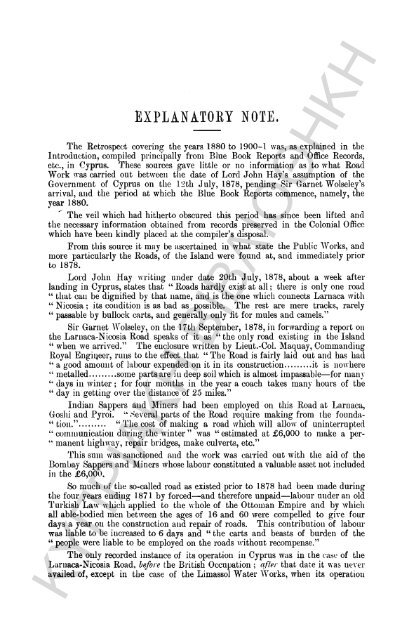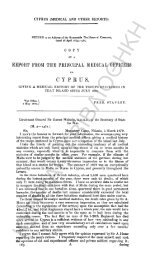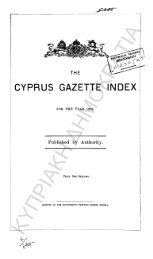THE MAIN ROADS OF CYPRUS
THE MAIN ROADS OF CYPRUS
THE MAIN ROADS OF CYPRUS
Create successful ePaper yourself
Turn your PDF publications into a flip-book with our unique Google optimized e-Paper software.
EXPLANATOEY NOTE.<br />
The Retrospect covering the years 1880 to 1900-1 was, as explained in the<br />
Introduction, compiled principally from Blue Book Reports and Office Records,<br />
etc., in Cyprus. These sources gave little or no information as to what Road<br />
Work was carried out between the date of Lord John Hay's assumption of the<br />
Government of Cyprus on the 12th July, 1878, pending Sir Garnet Wolseley's<br />
arrival, and the period at which the Blue Book Reports commence, namely, the<br />
year 1880.<br />
The veil which had hitherto obscured this period has since been lifted and<br />
the necessary information obtained from records preserved in the Colonial Office<br />
which have been kindly placed at the compiler's disposal.<br />
From this source it may be ascertained in what state the Public Works, and<br />
more particularly the Roads, of the Island were found at, and immediately prior<br />
to 1878.<br />
Lord John Hay writing under date 20th July, 1878, about a week after<br />
landing in Cyprus, states that " Roads hardly exist at all; there is only one road<br />
" that can be dignified by that name, and is the one which connects Larnaca with<br />
" Nicosia ; its condition is as bad as possible. The rest are mere tracks, rarely<br />
" passable by bullock carts, and generally only fit for mules and camels."<br />
Sir Garnet Wolseley, on the 17th September, 1878, in forwarding a report ou<br />
the Larnaca-Nicosia Road speaks of it as " the only road existing in the Island<br />
" when we arrived." The enclosure written by Lieut.-Col. Maquay, Commanding<br />
Royal Engineer, runs to the effect that " The Road is fairly laid out and has had<br />
"• a good amount of labour expended on it in its construction it is nowhere<br />
" metalled some parts are in deep soil which is almost impassable—for many<br />
" days in winter ; for four months in the year a coach takes many hours of the<br />
" day in getting over the distance of 25 miles."<br />
Indian Sappers and Miners had been employed on tliis Road at Larnaca,<br />
Goshi and Pyroi. '^ Several parts of the Road require making from the founda-<br />
" tion." "The cost of making a road which will allow of uninterrupted<br />
" communication during the winter " was " estimated at £6,000 to make a per-<br />
'' manent highway, repair bridges, make culverts, etc."<br />
This sum was sanctioned and the work was carried out with the aid of the<br />
Bombay Sappers and Miners whose labour constituted a valuable asset not included<br />
in the £6,000.<br />
So much of the so-called road as existed prior to 1878 had been made during<br />
the four years ending 1871 by forced—and therefore unpaid—labour under an old<br />
Turkish Law wiiich applied to the whole of the Ottoman Empire and by which<br />
all able-bodied men between the ages of 16 and 60 were compelled to give four<br />
days a year ou the construction and repair of roads. This contribution of labour<br />
was Uable to be increased to 6 days and " the carts and beasts of burden of the<br />
" people were liable to be employed on the roads without recompense."<br />
The only recorded instance of its operation in Cyprus was in the case of the<br />
Larnaca-Nicosia Road, lefore the British Occupation ; after that date it was never<br />
availed of, except in the case of the Limassol Water Works, when its operation<br />
ΚΥΠΡΙΑΚΗ ΒΙΒΛΙΟΘΗΚΗ

















